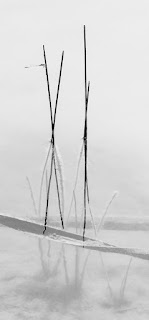- C. G. Jung (1875-1961)
Psychological Types
Sunday, February 13, 2022
Cosmic Tree
Saturday, February 12, 2022
Nothing is Dead
there was blackness,
pure and beautiful Nothing.
There was no thing in it,
no star, no wind,
no light, no word,
no broken heart.
But a time came when perfect,
restful Nothing was to vanish
forever. Something was
about to be.
Suddenly, there it was.
Something, all alone, king
of everything. Killer
of ancient, beautiful
Nothing. There was
a silence.
...till Nothing screamed
a death scream and
that scream is still screaming,
an expanding ring into the
universe that will never end.
Nothing is dead…"
- Joseph Pintauro (1930 - 2018)
To Believe in Things
Friday, February 11, 2022
Ethereal Being
whirlwind, of wings of purple and
azure, in the midst of which floated
an elusive form veiled by the very
The ethereal being which took
shape confusedly through this
quivering of wings seemed to you
chimerical, imaginary, impossible
to touch, impossible to see.
But when at last the young lady
was resting at the tip of a reed
and you could examine,
holding your breath,
the long gauze wings,
the long enamel dress,
the two crystal globes,
what astonishment did
you not feel? "
Wednesday, February 09, 2022
We are Stories
complicated centimeters
lines drawn by traces
left by the (re)mingling
together of things in the
world, and oriented toward
the direction of increasing
entropy, in a rather particular
corner of this immense,
chaotic universe."
Sunday, February 06, 2022
Cosmic Sea of Energy
It is full, a plenum
as opposed to a vacuum,
and is the ground for
the existence of everything,
including ourselves.
The universe is not separate
from this cosmic sea
of energy.
quantum interconnectedness
is that the whole universe
is enfolded in everything,
and that each thing is
enfolded in the whole."
Saturday, February 05, 2022
Mathematical Beauty
world is made manifest
in Form and Number,
and the heart and soul
and all the poetry of
Natural Philosophy are
embodied in the concept
of mathematical beauty."
- D'Arcy Wentworth Thompson (1860 - 1948)
Postscript. As may be the case with many of you, my day-job constraints leave me precious little time to devote to purely aesthetic pleasures (notwithstanding those that occasionally overlap with more mathematical pursuits). Sometimes, as now, even my weekend time is filled mostly with staring at gibberish on a computer screen, and pounding away at my keyboard to produce picture-less reams of technical reports (even as I day-dream of month-long photo-safaris in far-away lands). Thus, the short walks my wife and I take through our neighborhood after breakfast each day have become immeasurably important physical and spiritual oases for me. The simple pleasure of encountering beautifully haphazard arrangements of natural forms rejuvenates and nourishes my soul. The images in the triptych above were taken no more than a few minutes apart during a walk that itself lasted less than a half hour. But what a joy it is to stumble upon such humble transcendent beauty hiding in plain sight! The great polymath Thompson's book, On Growth and Form (the first edition of which came out in 1917, and which to this day remains an extraordinarily beautiful book to read) is essentially a 1100+ page erudite argument that biology can be reduced to mathematics (a sentiment that a much younger version of myself would have been happy to accept): "It behooves us always to remember that in physics it has taken great men to discover simple things. They are very great names indeed which we couple with the explanation of the path of a stone, the droop of a chain, the tints of a bubble, the shadows in a cup. It is but the slightest adumbration of a dynamical morphology that we can hope to have until the physicist and the mathematician shall have made these problems of ours their own." For those of you interested in exploring (taking a deep-dive, really, into) the broader entanglement of art and science, here are some slides I used for a 2017 presentation at a Humanities and Technology Association conference (held that year in Newport, RI). This lecture is one of three I've given in (relatively) recent years during which I wore both of my hats, as physicist and photographer. The other two lectures were given at the American Center for Physics (College Park, MD in 2009) and at the Morrison House (Alexandria, VA in 2011).
Sunday, January 30, 2022
New Riddles
- Alfred Noyes (1880 - 1958)







